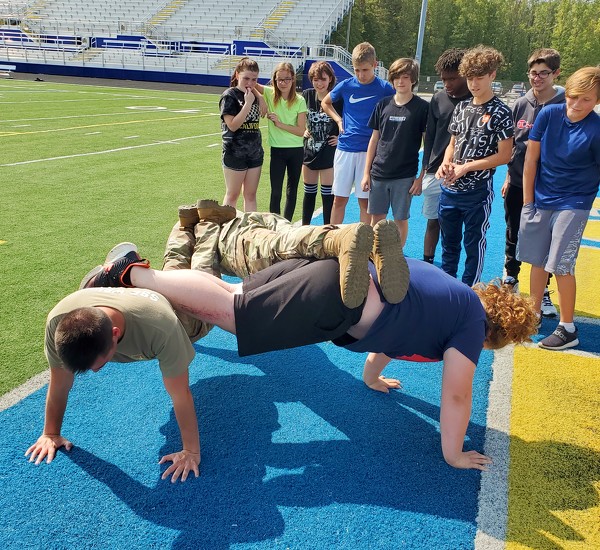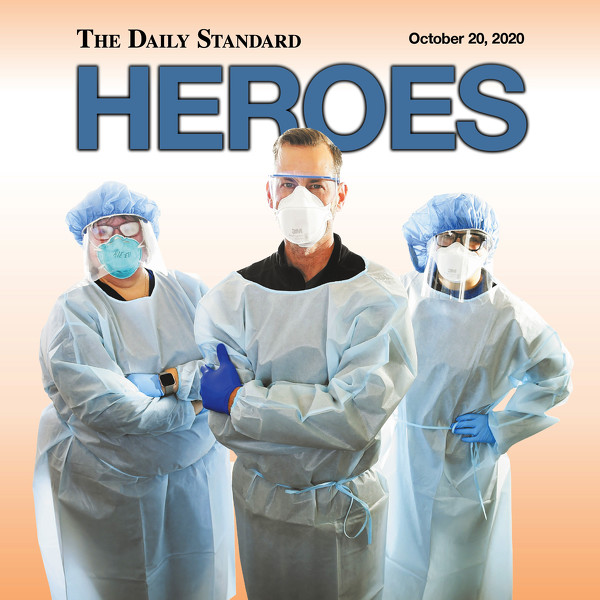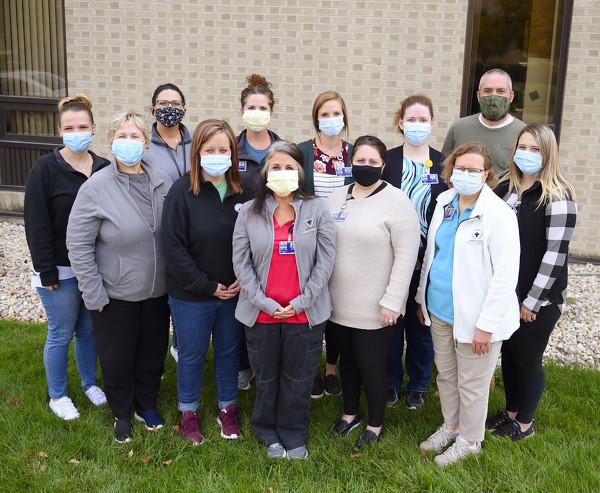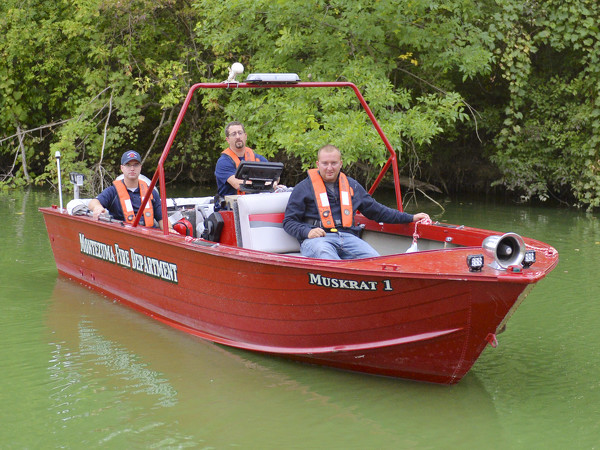Tuesday, October 20th, 2020
Many youth disqualified from military
By Amy Kronenberger

Submitted Photo
St. Marys eighth-grader Evin Shaffer takes part in pyramid pushups with Army Staff Sgts. Robert Brown and Dakota Wright during Monica VanderHorst's gym class on Sept. 24.
Only 29% of youth nationwide qualify for military service, according to 2017 Pentagon data, and local recruiters said these findings are reflected in northwest Ohio.
The Pentagon's top reasons for disqualification include obesity, not being academically ready and having a criminal record.
"Approximately 70% of those 17- to 24-year-olds … are disqualified for either moral, physical or educational deficiencies, and northwest Ohio is very much in line with the Department of Defense and the United States as a whole," Command Sgt. Maj. Justin Sprankle of the Ohio Army National Guard said.
The list of disqualifiers for northwest Ohio "runs the gamut," Sprankle said. Youth from urban areas may struggle more with the academic aspects and may be more likely to have a criminal history, but obesity can be a problem anywhere.
"Northwest Ohio is not atypical," he said. "I actually was a recruiter in the Defiance area for a short time, and the difficulties with recruiting are the same in northwest Ohio as they are throughout the state for the most part."
Sgt. Seth Coey of the Army recruiting office in Lima cited obesity as a top concern.
"Obesity is pretty high. That is a large disqualifier that we see," he said. "I would say in our area, those (obesity and low academic scores) are the two largest reasons" for ineligibility.
Celina City Schools Superintendent Ken Schmiesing and St. Marys City Schools Superintendent Bill Ruan agreed obesity is an issue - locally and nationally. Ruan said, however, he does not think the 71% disqualification rate represents the Grand Lake area.
"To me the 71% seems really high for this area. Almost all of our students would meet the academic part, and very few would have criminal records that would keep them out," he said. "I do think obesity is an issue for a large portion of all Americans but think the percent that it would keep out of the armed forces in this area would still be relatively small."
To qualify for military service, recruits must pass a physical examination and meet a specified weight-height ratio.
"We go through, ensure that they're able to operate without any kind of medications, check to see if they've ever had any broken bones, any allergies, … any pins, plates, screws. Things like that are the larger things we're looking for," Coey said. "We want to make sure there are no pre-existing conditions that would cause issue down the line."
Sprankle said height and weight are used as a baseline to determine healthy size, but other aspects also are considered.
"Say someone is a body builder … they may be heavier than what their allowable height says they can be, but if they're solidly built and are large through the upper body and small waisted, then we have what is called a tape test (and we'll) measure their body-fat percentage."
Academically, youth must have a high school diploma or GED and pass the Armed Services Vocational Aptitude Battery exam, which Sprankle said everyone in the Department of Defense must take to establish educational and mental criteria.
"We do see a percentage of students that are unable to even pass that," Coey said.
Legal troubles also can disqualify a candidate, but it depends on the severity of the offense," Sprankle said.
"A single speeding ticket is not going to keep you out," he said. "There are certain things that are absolutely not permissible, felony offenses would be one of those, but there's certain other offenses that different approval authorities may be able to permit based on the whole-person concept."
Youths who do not meet requirements are not simply turned away, Coey said. The Lima Army recruiting office offers tutoring and fitness programs to help them meet their goals.
"We try to work with pretty much everybody, especially if it's an overweight issue or an education issue," he continued. "We honestly try to work with everybody to make it possible. If they come to me and they tell me that they want to join the Army, that's my goal as well, is to get them to that point where they are qualified."
On the local level, Celina and St. Marys high schools offer health and physical education classes along with plenty of extracurricular activities to help students reach their fitness goals. Schmiesing and Ruan said military recruiting officers visit the schools regularly to speak with students, and both schools honor graduates who choose to enlist. Celina averages about five students per year who pursue the military, and St. Marys averages about 10 students, they said.
St. Marys physical education and health teacher Monica VanderHorst said she has close contact with the military branches and has representatives regularly visit her classes.
"They come into my PE classes, 8-12 grades, and help with circuit training," she said. "I feel since the military is introduced to my students in the eighth grade, they see the branches each year and it does have an influence on them. Students enjoy the interaction. (They) love the high-intensity workouts and the factual information about their branches."
Her students also watch a PowerPoint presentation in health class and learn about military meals ready to eat; the caloric information; and what is needed for muscles to work at their highest endurance level.
Despite the high number who do not qualify nationally, Coey said Army recruiting is going well locally and numbers have been consistent in recent years.
"We're doing great," he said. "It's been a pretty steady flow for the last two years that I've been here."
Sprankle said enlistment specifically in Mercer and Auglaize counties has jumped - from three people in 2019 to eight this year in Auglaize and from two to six people during the same time frame in Mercer County. Overall, however, enlistment goals this year have not been reached - due to the COVID-19 pandemic.
"This can definitely be attributed to limited access to our high schools, limited access to public places, limited ability for our organization to be able to get into their offices and things of that nature, so it has definitely been a challenge," Sprankle said. "With that said, I feel that we have embraced that challenge."








